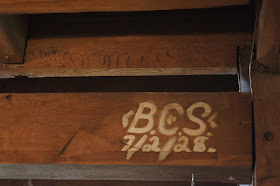 |
| Nolt's Mill in Bird-In-Hand, Lancaster County, Pennsylvania |
 |
| The main entrance at the rear of the mill. |
 |
| Water from a nearby creek is diverted into the mill to power the mill. |
 |
| The artwork of John is displayed on the walls of the mill. |
 |
| The original office, but is now display space. |
 |
| The office as it appears now. |
 |
| This was the miller's home and now serves as the home of the owners. It sets to the right of the mill. |
 |
| Cornerstone on the house telling when it was built. |
 |
| Weathervane is a quill pen. |
 |
| On one of the silos is this beautiful window with flowers. |
 |
| Lancaster County marker near the Mill Creek. |
 |
| This is the rear of the building which is where the entrance to the art gallery is located. |
 |
| The historical plaque on the building. |
 |
| This is an opening in the floor inside the gallery. Through it you can see the gears that powered the grist mill. Running water can be seen running underneath the gears. |
 |
| This photo shows where people placed their initials and the date. Great way to tell whom might have owned the mill or perhaps worked there at any specific date. |
 |
| A photo of the Midget Marvel Mill being removed during the renovation of the mill into a gallery. |
 |
| A photo of a worker actually running the Midget Marvel Mill when the plant was in action. |
 |
| This mechanical device still stands where bags were filled with flour. |
 |
| Plaque near the entrance telling of the date when the mill was built. |
 |
| A 1907 barn at the rear of the mill. The three vehicles, all VWs, are still in use. One is for transporting artwork to shows throughout the region. |

No comments:
Post a Comment